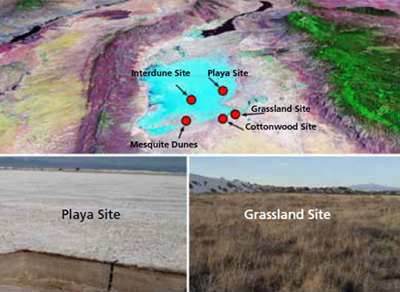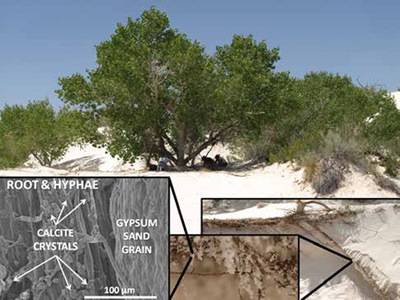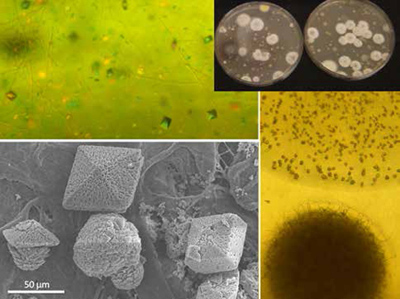Beneath your feet as you walk across the gypsum dunes and soils of White Sands National Monument is an ecosystem of roots and millions and millions of microorganisms that live in the pore spaces between sand grains.
This invisible ecosystem is as complex as any rain forest on Earth. There are bacteria that capture, transform, and release nitrogen. There are complex networks of fungal hyphae that carry nutrients to roots. There are microscopic animals that feed on the fungi, and fungi that feed on the animals.

Top: NASA World Wind; Bottom: Curtis Monger.
Such subterranean ecosystems are some of the most populated and ancient ecosystems ever to exist on the planet. A handful of rich garden topsoil, for example, will contain more microorganisms than the seven billion people on Earth. Geologic evidence preserved in rocks reveals that microorganisms inhabited soils of ancient landscapes millions of years before plants colonized land.
Although it is a widely known that organisms in the ocean produce calcium carbonate (calcite) as sea shells, it is less widely known that organisms in desert soils also produce calcite. The process of organisms making calcite, or any other mineral, is known as biomineralization. There are two types of biomineralization—“biologically controlled” and “biologically induced.” Biologically controlled occurs when organisms have specialized tissue where minerals are purposefully generated. Biologically induced occurs when organisms inadvertently create an extraneous environment that brings together the ingredients needed to make minerals. At White Sands National Monument, calcium carbonate appears to be biologically induced by many microorganisms, but it is unknown what type of microbes, how many, and at what rate they are involved, and if the aboveground ecosystem is the main controlling factor for biomineralization.
|
Research Objectives The overall objective of this study was to better understand microbial biomineralization at White Sands National Monument. Toward this goal, we selected five ecosystems—a playa, an interdune area, a cottonwood grove, a grassland, and a mesquite dune site (Figure 1). Specific objectives included answering the following questions: Objective 1 - Do microorganisms at White Sands have the ability to crystallize calcium carbonate? |
Methods
We visited the playa, interdune, cottonwood, and grassland sites monthly, and the mesquite dune site seasonally because of its remoteness. We collected soil samples from which we cultured microorganisms in the lab on solid and liquid media. The solid medium contained glucose, calcium acetate, yeast extract, and agar adjusted to pH 8. Microbes were grown on the solid medium to determine which microbes produce calcite and to separate them for identification. The liquid medium contained the same chemical ingredients, except for agar, which makes it easier to extract crystals.
To measure the natural rate of calcite formation in the soil, we buried small ceramic tiles at 10 centimeters, let them reside there for one month, then harvested and replaced them with new tiles. The tiles were taken back to lab, observed with a microscope and tested for calcite formation. We also measured soil temperature, moisture content, carbon dioxide, and calcium content.
Findings

Curtis Monger
The site with the lowest number of microorganisms of the four sites visited monthly was the playa, followed by the interdune, the cottonwood, and grassland sites (Table 1). The playa was also the site with the least amount of microbial biodiversity, and the site where very little, if any, calcite was produced. In contrast, both the grassland and cottonwood sites contained abundant bacteria, actinomycete, and fungi that produced calcite. Calcite, for example, can be viewed on hyphae associated with roots at the cottonwood site using electron microscopy (Figure 2).
Many colonies of microorganisms cultured on the solid medium do not produce calcite. These microbes and the calcite-producing microbes are being identified using genetic sequencing techniques. The microbes that do produce calcite generate crystals with many shapes, including spheres, dumbbells, aggregates, laths, rods, and pyramids (Figure 3). Not all the crystals, however, are calcite. The pyramid-shaped crystals are calcium oxalate, which is a mineral commonly produced in plants.
| Table 1. Number of microorganisms per gram of soil based on the number of colonies that developed on the solid medium cultured in the lab. | |
|
Site
|
Miicrobes/gram of soil
|
|
Playa
|
16,600
|
|
Interdune
|
26,600
|
|
Cottonwood
|
83,300
|
|
Grassland
|
220,000
|
Discussion

Curtis Monger
As a scientific phenomenon, biomineralization itself is interesting enough to merit study, especially in the unique and diverse gypsum habitats of White Sands. But because desert soils cover about one-third of the Earth’s land surface, a better understanding of calcite biomineralization is needed. This is because calcite contains carbon derived from the atmosphere. Therefore, desert soils have the capacity to be managed to absorb and store carbon dioxide from the atmosphere, thereby offsetting the steady increase of carbon dioxide resulting from fossil fuel combustion.
Management Implications
The greater abundance of calcifying microorganisms and calcite formation in the grassland and cottonwood sites, in contrast to the playa and interdune sites, indicates that biomineralization is directly linked to the aboveground ecosystem. The limiting reactants in the formation of calcite appear to be carbon dioxide from root and microbial respiration and water. Therefore, any management techniques that could stimulate respiration and create a temporary aqueous environment for crystal formation might also increase carbon sequestration.
Recommendations
White Sands National Monument is unique for studying biomineralization because its pure gypsum substrate greatly reduces the number of variables that complicate similar studies in soils with more complex silicate mineralogy. White Sands is also unique because biomineralization can be studied in extreme plant-free environments, like the playa, and compared to neighboring robust ecosystems, like the grassland and cottonwood sites. Because of its natural uniqueness, no management changes should be undertaken. Instead, future research should be conducted to advance our understanding of fundamental biomineralization processes and carbon sequestration that could be applied to neighboring deserts dominated by silicate mineralogy. Future research is also needed at White Sands that focuses on microbial life in extreme environments, which can improve our understanding and, perhaps, assist with the discovery of life in extreme environments of other planets.
For more information, contact:
H. Curtis Monger, cmonger@nmsu.edu
Prepared in collaboration with Pete Biggam, Geologic Resources Division, National Park Service, 2012.
Last updated: December 4, 2016
